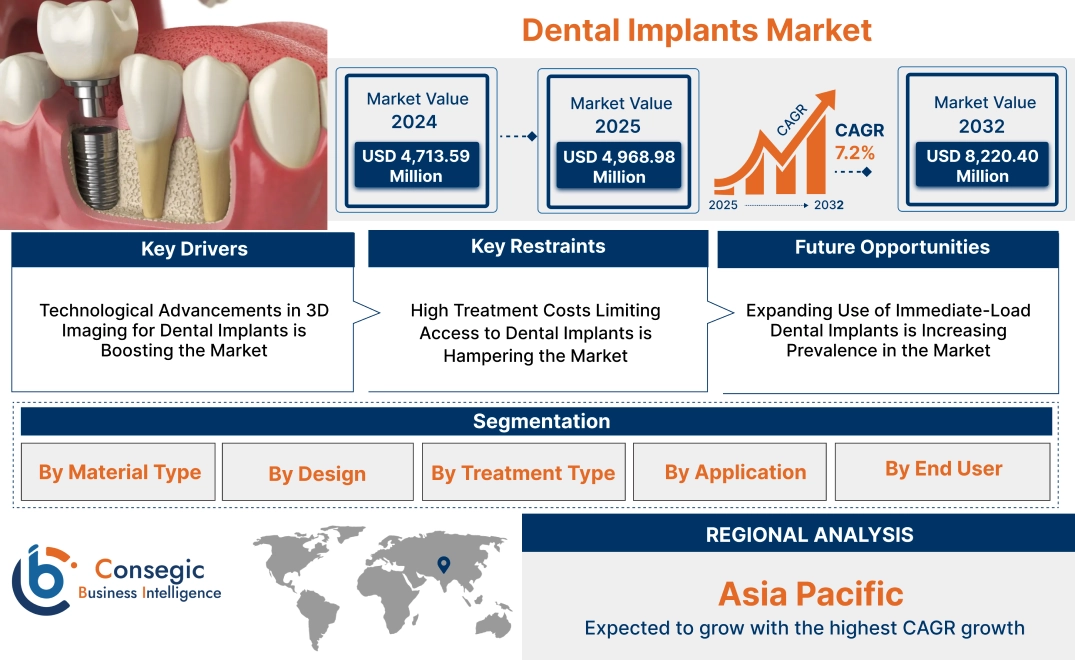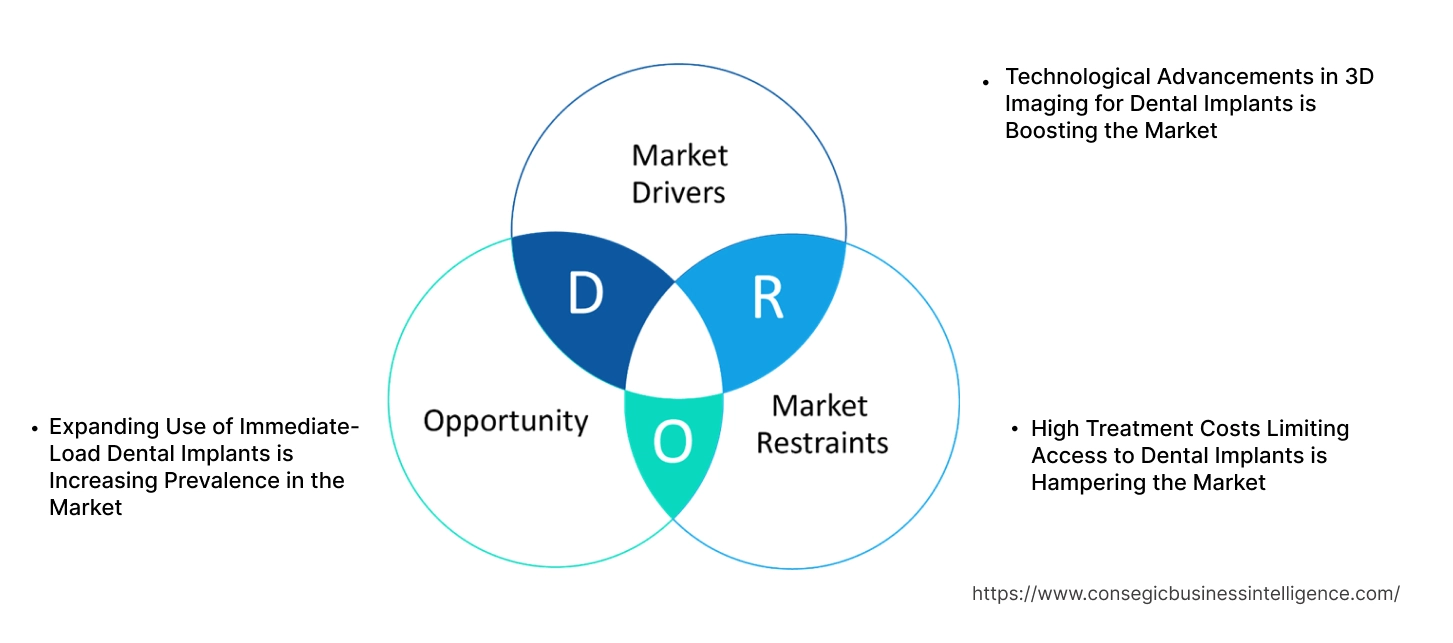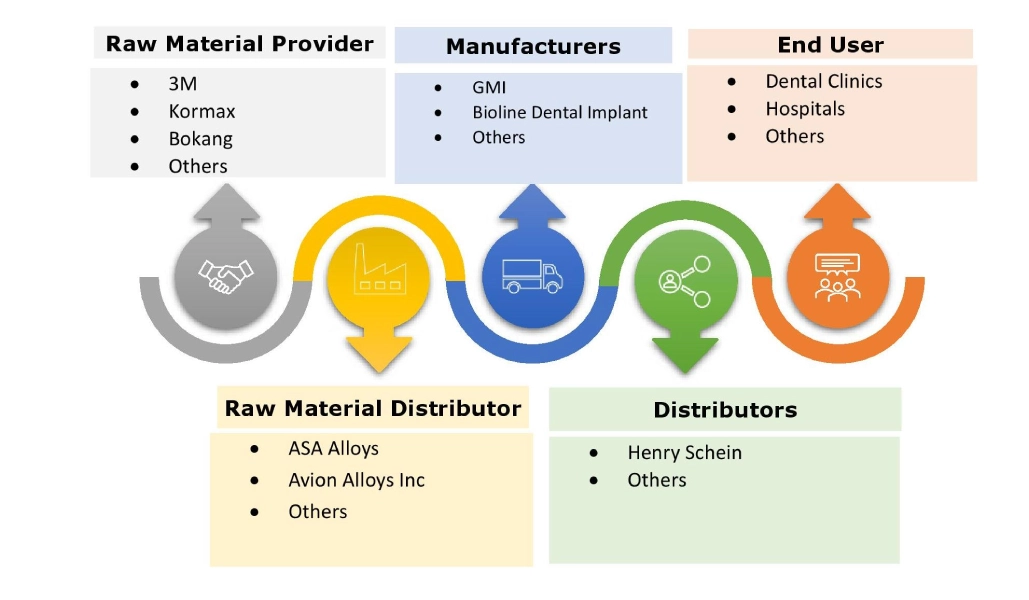Dental Implants Market Size:
Dental Implants Market size is estimated to reach over USD 13.96 Billion by 2032 from a value of USD 6.50 Billion in 2024 and is projected to grow by USD 7.04 Billion in 2025, growing at a CAGR of 7.90% from 2025 to 2032.
Dental Implants Market Scope & Overview:
A dental implant is a dental treatment solution that is surgically placed into the jawbone to serve as an artificial root for a replacement tooth. Also, Implants are a long-term solution for replacing missing teeth, restoring function, appearance, and comfort by integrating with the bone through a process called osseointegration. The key advantages driving the dental implants market growth include natural look and feel, long-term solution, improved function and aesthetics, and others. Further, implants are preferred over traditional removable prosthetics due to the superior and satisfactory results, making them an integral part of restoring a patient's oral health is driving the dental implants market demand.
How is AI Transforming the Dental Implants Market?
AI algorithms can analyze radiographic images to detect issues and identify structural positioning with high precision, which in turn is improving the accuracy of initial assessments. Also, AI software allows for digital simulation of implant placement, enabling clinicians to design and plan procedures with greater accuracy. Further, AI helps with improved patient outcomes, reduced healthcare costs, increased efficiency and productivity, and others. Furthermore, AI tools help clinicians with everything from early detection of peri-implantitis to simulating complex implant placements, thereby enhancing treatment is driving the dental implants industry.
Dental Implants Market Dynamics - (DRO) :
Key Drivers:
Superior Functionality and Aesthetics Drive Demand for Dental Implants
The rising demand for implants due to superior functionality and aesthetics, which mimic natural teeth while restoring oral health and appearance, is driving the dental implants market growth. Additionally, the factors influencing the dental implants market demand include aging population, advancements in materials as well as social media influence. Further, the extended benefits of implants over traditional options such as dentures are boosting the functionality and aesthetics of implants.
- For Instance, in January 2021, zirconia offered superior strength and aesthetics in dental implants due to the integration of titanium, which is shifting from metal-free dental reconstructions. Also, the enhanced aesthetic potential and higher mechanical strength compared to traditional metals are fueling the market adoption.
Therefore, the rising demand for implants with enhanced aesthetic potential and higher mechanical strength is driving the growth of the market.
Key Restraints:
Superior Functionality and Aesthetics Drive Demand for Dental Implants
The primary restraints in the market are the high cost associated with the procedure, which includes the implant, surgery, consultations, and post-operative care. Also, the cost of dental implants is significantly higher than other traditional dental restoration options, which in turn is hindering the dental implants market expansion. Further, the price barrier limits the number of individuals who can afford treatment, leading to slower adoption of advanced dental technologies across regions.
Hence, the high treatment costs of implants are hindering the dental implants market expansion.
Future Opportunities :
Surging Demand for Faster Treatment is Expected to Promote Potential Opportunities for Market Growth
The need for implants is rising due to faster, technologically advanced treatments, promoting market growth by improving efficiency and accessibility. Additionally, the higher prevalence of dental issues like decay and periodontal disease, and advancements in digital technologies such as CAD/CAM and 3D printing that speed up procedures and recovery times, are paving the way for dental implants market opportunities. Further, the growing number of older adults with higher tooth loss rates, as well as tooth loss due to dental caries and periodontal disease, is boosting the market progress.
- For instance, in July 2025, ClearChoice Dental Implant Center launched a brand campaign to promote same-day, full-arch dental implant treatment for patients with a daily source of stress, embarrassment, or isolation.
Hence, the higher prevalence of dental issues is anticipated to increase the utilization of digital technologies, in turn promoting prospects for the dental implants market opportunities during the forecast period.
Dental Implants Market Segmental Analysis :
By Material Type:
Based on the material type, the market is segmented into porcelain, titanium, ceramics, zirconium, and others.
Trends in the Material Type:
- The ongoing research in the field of exploring other alloys to achieve better mechanical strength and biocompatibility for various applications is driving the dental implants market trends.
- The development of stronger ceramic types and the focus on improving bone integration for better long-term success are driving the adoption of porcelain material, which in turn is fueling the dental implants market trends.
Titanium accounted for the largest revenue share of 56.20% in the year 2024.
- Titanium implants are a solution for tooth loss, by utilizing a titanium alloy screw that is fixed with the jawbone to act as a stable artificial tooth root.
- The primary benefits include biocompatibility, strength, durability, and the ability to restore natural chewing and appearance is driving the dental implants market share.
- Additionally, Titanium's unique property of osseointegration has made it the preferred choice for both single-tooth and full-arch restorations.
- Further, the titanium's ability to interact harmoniously with the body, causing minimal inflammation or allergic reactions, is driving the dental implants market share.
- Furthermore, the rise of advancements in implant surface treatments, as well as new titanium alloys for better performance, is driving the dental implants market size.
- Thus, as per the dental implants market analysis, the ability to interact harmoniously with the body, as well as technological advancement, is driving the dental implants market size.
Zirconium is anticipated to register the fastest CAGR during the forecast period.
- Zirconium-based implants are an alternative to ceramic as well as traditional titanium implants by offering tooth-like color, excellent biocompatibility, and good mechanical strength.
- Also, they provide superior aesthetics and can reduce plaque adhesion, and potential metal allergy is driving the adoption of zirconium-based implants.
- Additionally, the key advantages include biocompatibility, reducing allergic reactions, inflammatory responses, and others.
- Further, the increasing adoption of metal-free implants in cosmetic dentistry is driving the adoption of zirconium implants.
- Therefore, as per the dental implants market analysis, the superior aesthetics as well as the need for metal-free implants are anticipated to boost the market during the forecast period.
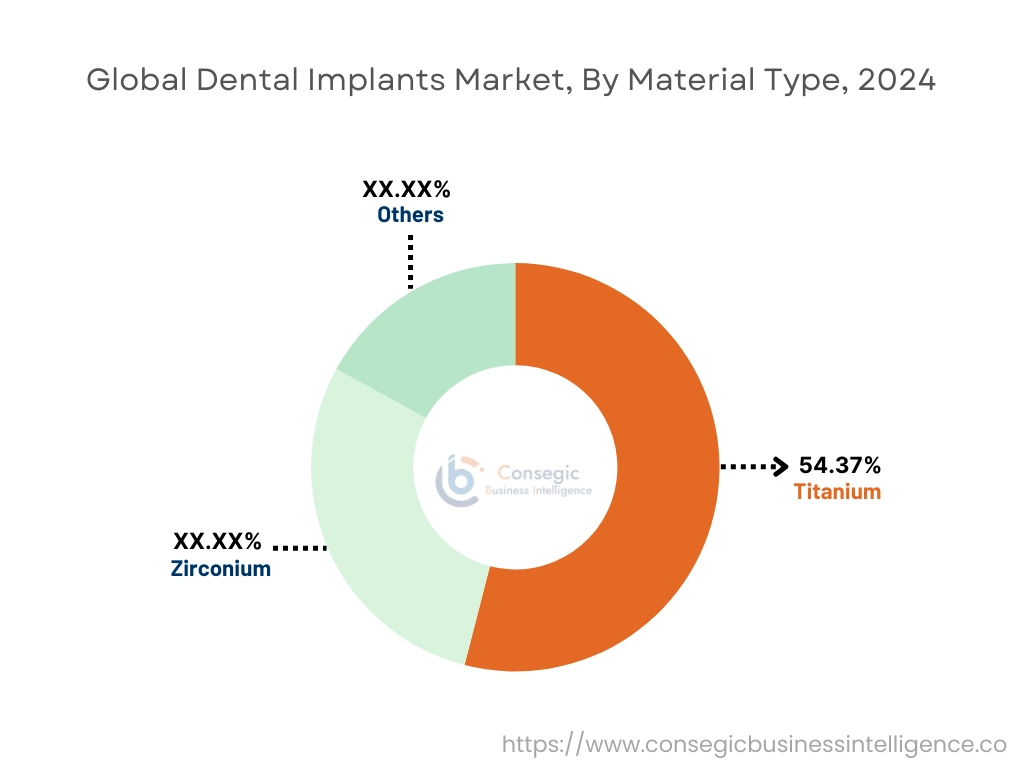
By Treatment Type:
Based on the treatment type, the market is segmented into endosteal implants, subperiosteally implants, and zygomatic implants.
Trends in the Treatment Type:
- The increasing patient demand for long-lasting, aesthetic results is driving the need for zygomatic implants.
- The trend towards the rising focus on eliminating invasive surgical impressions and enabling the creation of patient-specific, highly accurate implants is boosting the adoption of modern subperiosteally implants.
Endosteal Implants accounted for the largest revenue share in the year 2024.
- Endosteal implants are the most common type of implants, where a titanium implant are surgically placed directly into the jawbone to serve as a stable, artificial tooth.
- Also, the process is called osseointegration, where the implant is fixed with the surrounding bone, providing a strong, long-term solution for missing teeth.
- Additionally, the key advantages include exceptional stability, a natural look and feel, a proven high success rate, and others are driving the market progress.
- Further, the advancements in implant materials and techniques as well as growing prevalence of tooth loss are driving the need for endosteal implants.
- Furthermore, the wide range of applications, from single-tooth to full-arch restorations is driving the adoption of endosteal implants.
- Thus, as per the market analysis, the aforementioned factors are driving the market evolution.
Zygomatic Implants is anticipated to register the fastest CAGR during the forecast period.
- Zygomatic implants are long implants anchored into the cheekbone instead of the jawbone, for providing a stable option for patients with severe maxillary atrophy.
- Also, these implants are particularly useful after tumor resection, trauma, or congenital defects, and offer a less invasive alternative to bone grafting for full-arch dental restorations.
- Additionally, the key benefits include no bone grafting needed, reduced treatment time, high stability and strength and immediate functionality, among others.
- Further, the treatment is a primary solution for patients who have lost a significant amount of upper jaw bone, a common issue after tooth extraction or with conditions like cleft palate.
- Therefore, the aforementioned factors are anticipated to boost the market during the forecast period.
By Application:
Based on the application, the market is segmented into single-tooth restoration, multiple-tooth restoration, and full-arch restoration.
Trends in the Application:
- The trend towards ongoing advancements in zirconia and other biomaterials for better aesthetics in multiple-tooth restoration is driving the market progress.
- The trend towards rising focus on personalization and customization is driving the market adoption of full-arch restoration applications.
Full-Arch Restoration accounted for the largest revenue share in the year 2024.
- Full-arch restoration using implants which replaces a full set of missing teeth with a single, fixed prosthesis supported by multiple implants.
- Also, this advanced restorative treatment significantly improves a patient's quality of life by restoring oral function and aesthetics, offering a long-term, stable solution.
- Additionally, the key advantages include jawbone preservation, stability & security, improved bite function, natural appearance, long-lasting solution, and others.
- Further, the patient's desire for stable, comfortable, and natural-looking teeth is driving the adoption of full-arch restoration.
- Furthermore, the technological advancements in digital planning and materials that enable precise, patient-specific treatment are boosting the market for full-arch restoration.
- For instance, REVA Dental Implant Center, which is a leading transformative dental implants company providing full-arch restoration, offers clarity, access, and a first-of-kind approach for a permanent, natural-looking smile.
- Thus, as per the market analysis, the technological advancements in digital planning and materials, as well as patients' desire, are driving the adoption of full-arch restoration.
Single-Tooth Restoration is anticipated to register the fastest CAGR during the forecast period.
- A single-tooth restoration with a dental implant is a procedure to replace one missing tooth with the help of titanium implants into the jawbone.
- Also, this process restores both the look and function of the missing tooth, preserves jawbone integrity, and is a popular first-line strategy for tooth replacement.
- Additionally, the key advantages include preserving adjacent teeth, promoting jawbone health, natural appearance and feel, enhanced stability and function, among others.
- Further, the rising need for natural shape and color to integrate with surrounding teeth, as well as the growing population, is driving the need for single-tooth restoration.
- Therefore, as per the market analysis, the aforementioned factors are anticipated to boost the market during the forecast period.
By End-User:
Based on the end user, the market is segmented into hospitals, dental clinics, and research institutions.
Trends in the End User:
- The trend towards the development of multi-specialty hospitals is driving the adoption of implants due to advanced technology and interdisciplinary care for patients by hospitals.
- The rise of 3D printing, digital dentistry, and AI-assisted treatment planning is driving the adoption of dental clinics by patients.
The dental clinics accounted for the largest revenue share in the year 2024.
- Dental clinics offer a modern, effective solution for tooth loss by replacing missing roots with titanium posts, which are surgically placed into the jawbone.
- Additionally, the rising oral health issues, as well as an aging population, are driving the need for dental clinics across the globe.
- Also, the rising awareness about dental care, as well as the need for a sensible long-term solution for missing teeth, is driving the need for implants.
- Further, the increasing number of dental practices is boosting the market progress across the globe.
- For instance, in 2022, according to Eurostat, there were more than 363,000 practicing dentists, with Germany having the highest number of 71,297 practicing dentists in the EU countries.
- Thus, as per the market analysis, the increasing number of dental practices is driving the progress of dental clinics.
The hospital segment is anticipated to register the fastest CAGR during the forecast period.
- Hospitals are increasingly offering services such as oral surgery, and hospitals are ideal settings for restorative procedures due to integrated care through a team of specialists.
- Also, the one-stop solution for all dental problems, ranging from Consultation, Surgical Placement,Osseointegration, Abutment Placement, and other procedures in hospitals, is driving the market need.
- Further, the global rise in tooth decay and periodontal disease, and increased patient awareness of dental health and cosmetic procedures due to social media influence, is boosting the need for hospitals.
- Therefore, as per the market analysis, the aforementioned factors are anticipated to boost the market during the forecast period.
Regional Analysis:
The regions covered are North America, Europe, Asia Pacific, Middle East and Africa, and Latin America.
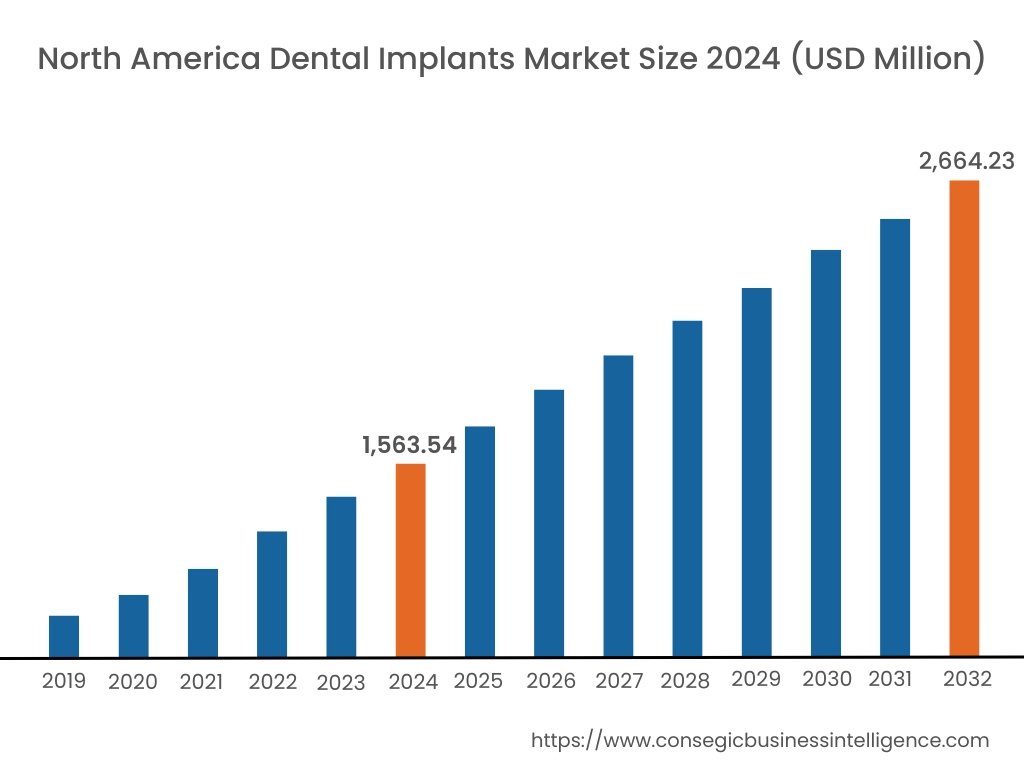
Asia Pacific region was valued at USD 1.74 Billion in 2024. Moreover, it is projected to grow by USD 1.89 Billion in 2025 and reach over USD 3.85 Billion by 2032. Out of this, China accounted for the maximum revenue share of 30.30%. The market progress is mainly driven by a significant and growing elderly population, leading to an increased risk of tooth loss and oral health issues. Furthermore, factors including the increasing disposable income, growing dental tourism industry, improving healthcare infrastructure, and others are projected to drive the market growth in the Asia Pacific region during the forecast period.
- For instance, in September 2025, Dentsply Sirona introduced advanced dental equipment in India, China, and Indonesia by partnering with Smile Train.
- Additionally, according to the Ministry of Tourism , India has been ranked 10th in the Medical Tourism Index for 2020-21 out of 46 destinations across the globe.
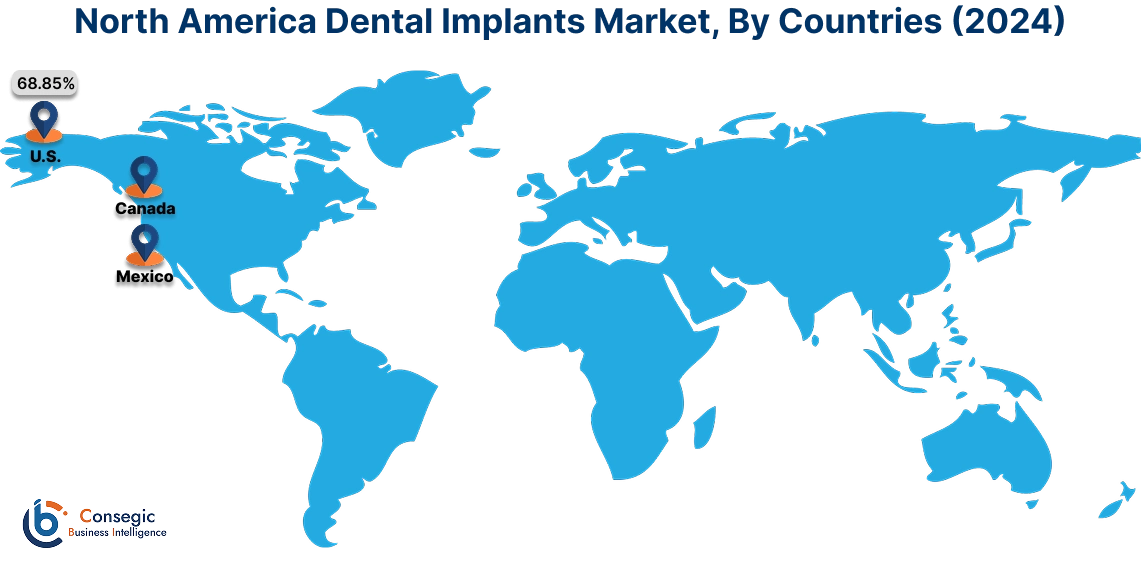
North America is estimated to reach over USD 4.54 Billion by 2032 from a value of USD 2.10 Billion in 2024 and is projected to grow by USD 2.27 Billion in 2025. The North American region's growing awareness of oral health and the benefits of implants offer lucrative growth prospects for the market. Additionally, the increasing need for cosmetic dentistry and aesthetic results, as well as the adoption of advanced technologies such as digital dentistry, is driving the market progress.
- For instance, according to the U.S. Centers for Disease Control and Prevention, 65.5% of adults aged 18 and older dental exam or cleaning in 2023, driving the need for dental services .
The regional analysis depicts that the growing awareness about the high prevalence of oral diseases like tooth loss and decay, as well as advancements in digital and technological innovation within dental care, is driving the market in Europe. Additionally, the key factor driving the market is the growing need for cosmetic dentistry, as well as improved healthcare infrastructure and rising disposable income is propelling the market adoption in the Middle East and African region. Further, the growing burden of dental diseases and increased patient awareness of oral health, as well as the need for high-quality implant treatment at lower costs, is paving the way for the progress of the market in the Latin America region.
Top Key Players & Market Share Insights:
The global dental implants market is highly competitive with major players providing implants to the national and international markets. Key players are adopting several strategies in research and development (R&D), product innovation, and end user launches to hold a strong position in the dental implants industry. Key players in the dental implants market include-
- GMI (Spain)
- Nobel Biocare Services AG. (Switzerland)
- Envista Holdings Corporation (United States)
- Osstem Implant Co., Ltd. (South Korea)
- BioHorizons IPH, Inc. (United States)
- Bioline Dental Implant (United States)
- Institut Straumann AG (Switzerland)
- Zimmer Biomet Holdings, Inc. (United States)
- Dentium Co., Ltd. (South Korea)
- Dentsply Sirona Inc. (United States)
Recent Industry Developments :
Product launches
- In June 2025, ZimVie announced the launch of RealGUIDE which is Software Suite service in Japan, aiming to provide a unique digital dental implant ecosystem.
- In February 2023, Zest Dental Solutions launched LOCATOR, which is an implant system that supports full arch dental implant treatment.
Expansion
- In August 2025, Nuvia Dental Implant Center expanded into seven new locations across the U.S. to provide access to its full arch dental implant treatment.
Dental Implants Market Report Insights :
| Report Attributes | Report Details |
| Study Timeline | 2019-2032 |
| Market Size in 2032 | USD 13.96 Billion |
| CAGR (2025-2032) | 7.90% |
| By Material Type |
|
| By Treatment Type |
|
| By Application |
|
| By End-User |
|
| By Region |
|
| Key Players |
|
| North America | U.S. Canada Mexico |
| Europe | U.K. Germany France Spain Italy Russia Benelux Rest of Europe |
| APAC | China South Korea Japan India Australia ASEAN Rest of Asia-Pacific |
| Middle East and Africa | GCC Turkey South Africa Rest of MEA |
| LATAM | Brazil Argentina Chile Rest of LATAM |
| Report Coverage |
|
Key Questions Answered in the Report
How big is the dental implants market? +
The dental implants market size is estimated to reach over USD 13.96 Billion by 2032 from a value of USD 6.50 Billion in 2024 and is projected to grow by USD 7.04 Billion in 2025, growing at a CAGR of 7.90% from 2025 to 2032.
Which segmentation details are covered in the dental implants report? +
The dental implants report includes specific segmentation details for material type, treatment type, application, end user, and regions.
Which is the fastest segment anticipated to impact the market growth? +
In the dental implants market, the zirconium material is the fastest-growing segment during the forecast period due to the superior aesthetics as well as the need for metal-free implants.
Who are the major players in the dental implants market? +
The key participants in the dental implants market are GMI (Spain), Nobel Biocare Services AG. (Switzerland), Bioline Dental Implant (United States), Institut Straumann AG (Switzerland), Zimmer Biomet Holdings, Inc. (United States), Dentsply Sirona Inc. (United States), Envista Holdings Corporation (United States), Osstem Implant Co., Ltd. (South Korea), BioHorizons IPH, Inc. (United States), Dentium Co., Ltd. (South Korea), and others.
What are the key trends in the dental implants market? +
The dental implants market is being shaped by several key trends including the rise of 3D printing, digital dentistry, and AI-assisted treatment planning, personalization, and customization, among others are key trends driving the market.
